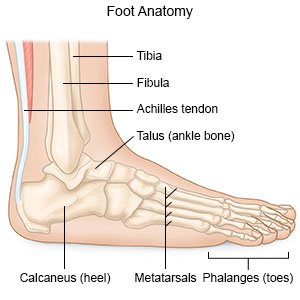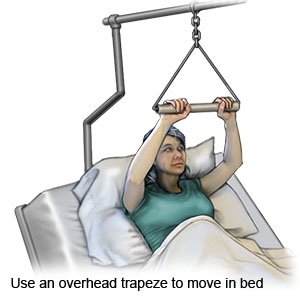Ankle Fracture
Medically reviewed by Drugs.com. Last updated on Aug 4, 2025.
An ankle fracture is a break in 1 or more of the bones in your ankle.
 |
WHILE YOU ARE HERE:
Informed consent
is a legal document that explains the tests, treatments, or procedures that you may need. Informed consent means you understand what will be done and can make decisions about what you want. You give your permission when you sign the consent form. You can have someone sign this form for you if you are not able to sign it. You have the right to understand your medical care in words you know. Before you sign the consent form, understand the risks and benefits of what will be done. Make sure all your questions are answered.
An IV
is a small tube placed in your vein that is used to give you medicine or liquids.
Overhead trapeze:
This is a metal triangle-shaped grab bar that is hung on the frame of your hospital bed. Healthcare providers will teach you how to safely use the trapeze to move and change positions while in bed.
 |
Medicines:
Pain medicine may be given. Do not wait until the pain is severe before you ask for more medicine.
Tests:
- An x-ray, ultrasound, CT, or MRI may show a fracture, tissue damage, or other injuries. You may be given contrast liquid to help the fracture show up better in the pictures. Tell the healthcare provider if you have ever had an allergic reaction to contrast liquid. Do not enter the MRI room with anything metal. Metal can cause serious injury. Tell the healthcare provider if you have any metal in or on your body.
- A bone scan is done to look at the bones in your body. This test shows areas where your bone is diseased or damaged. You will get a radioactive liquid, called a tracer, through a vein in your arm. The tracer collects in your bones. Pictures will then be taken to look for a fracture.
Treatment:
- Support devices , such as a brace, cast, or splint, or may be needed. These help to limit your movement and protect your ankle. You may need to use crutches to protect your ankle and decrease your pain as you move around. Do not remove your device and do not put weight on your injured ankle.
- Closed reduction may be done to put your bones back into their correct position without surgery.
- Open reduction surgery is done when a closed reduction does not work or you have ligament damage. An incision is made and the bones and ligaments are put back in the correct position. This may include the use of special wires, pins, plates or screws.
RISKS:
You may have pain or fluid buildup in your ankle joint for up to a year. You could get an infection or bleed more than expected with surgery. Even after surgery, your ankle may not go back to the way it was before, or your symptoms may not go away. A cast may cause discomfort and problems walking. You may get a blood clot in your leg or arm. This can cause pain and swelling, and it can stop blood from flowing where it needs to go in your body. The blood clot can break loose and travel to your lungs or brain. This can be life-threatening.
CARE AGREEMENT:
You have the right to help plan your care. Learn about your health condition and how it may be treated. Discuss treatment options with your healthcare providers to decide what care you want to receive. You always have the right to refuse treatment.© Copyright Merative 2025 Information is for End User's use only and may not be sold, redistributed or otherwise used for commercial purposes.
The above information is an educational aid only. It is not intended as medical advice for individual conditions or treatments. Talk to your doctor, nurse or pharmacist before following any medical regimen to see if it is safe and effective for you.
Learn more about Ankle Fracture
Treatment options
Care guides
Symptoms and treatments
Medicine.com guides (external)
Further information
Always consult your healthcare provider to ensure the information displayed on this page applies to your personal circumstances.
